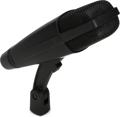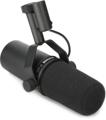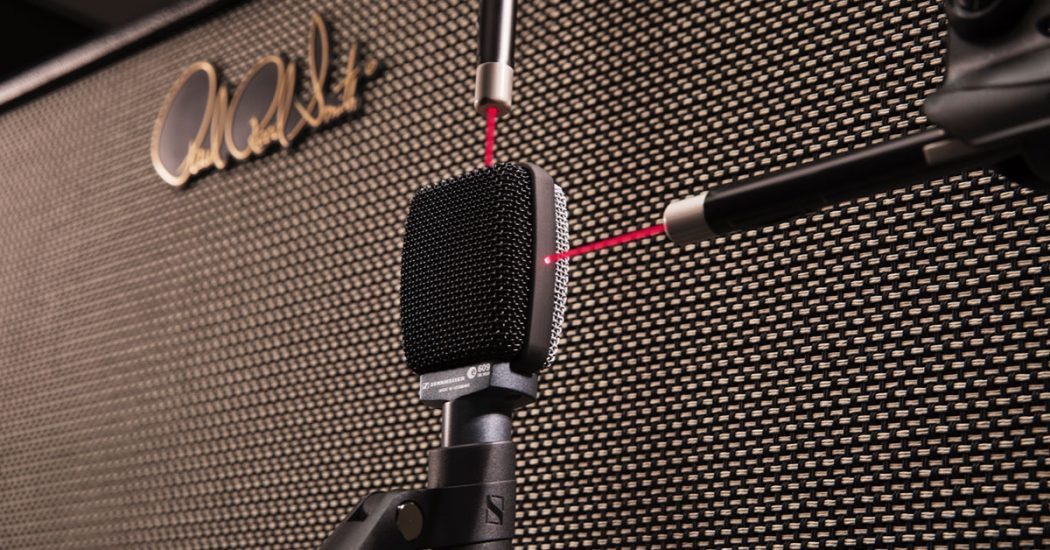
We all know that guitarists are obsessive about their tone, and rightfully so. They audition everything from guitars to amps, tubes, speakers, pickups, strings, pedals, even replacing capacitors and potentiometers in their guitars. But unless you’re playing guitar in a room where you don’t have to mic your amp, there’s one more component of your sound that is the conduit that allows everyone else to hear your guitar. That frequently underestimated component is the mic in front of your guitar cabinet.
I spent nearly 40 years as a recording engineer, and I’ve used dozens of different mics on guitar cabinets. I’ve learned first-hand what a drastic difference a mic can make in translating a guitarist’s tone, and it’s far more significant than many people realize. Some of the best studio and live players understand that the signal chain determing their sound doesn’t end when the sound comes out of their speaker cabinet. The signal chain follows all the way through to the mic — the ultimate arbiter of what is heard by listeners, whether in a club, in a coliseum, or on the radio.
Most people don’t have the luxury of auditioning dozens of guitar mics. For this article, I wanted to record a wide assortment of mics in order to show you how great an impact the microphone can make using identical source material and calibrated mic placement so the only variable is the microphone.
The process behind the guitar cabinet mic shootout
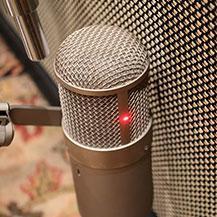
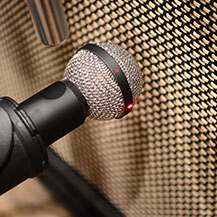
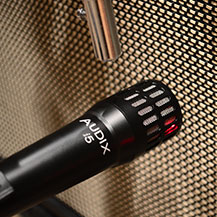
I started off by making a list of mics and circulating it among my engineering comrades here at Sweetwater Studios to see which mics I should include. And yes, these are all mics that Sweetwater currently sells. There are some perennial standards, such as the Shure SM57, Sennheiser MD 421 II, and Royer R-121, as well as some mics you may not know. I took all of them into Sweetwater’s Studio B and Sweetwater’s Don Carr provided the playing.
Because mic placement is paramount to how a mic sounds on a guitar cab, each mic was placed in exactly the same position on the speaker cabinet (details below). I decided to use two performances (one dirty and one clean) and used a re-amped signal for consistency so the performances are exactly the same every time. I went to great lengths to make sure that the test was fair and all the levels were matched (easier said than done). Don and I used premium components throughout the signal chain to make sure that the mics were presented in the best possible light. These sound clips will enable you to listen to 21 different mics, ranging in price from $99 to $3999, and hear how drastic a difference the microphone makes.
The goal was not to pick a “best” guitar mic, but rather to explore options. You may notice, as Don and I did, that mic preference often depends on the source material. You may like one mic best on the dirty sound and a completely different mic on the clean sound. As I’ve listened and shared these files, it’s been interesting to hear how widely varied the opinions are when it comes to what people like.
My hope is that you hear some mics you haven’t ever heard before, and if you’re like me, find some mics you like better than what you’ve been using. Hearing these clips is an opportunity to expand your sonic horizons and maybe figure out how they made those incredible guitar tones on some of your favorite recordings. Many engineers have listened and learned a lot including Sweetwater’s Mitch Gallagher, Nathan Heironimus and Bobby Dellarocco. Here are the details about what mics and other gear we used…
The 21 guitar amp mics we tested
- Shure SM57
- Telefunken M80-SH
- Telefunken M81-SH
- Audix i5
- sE Electronics V7
- Sennheiser e609
- Sennheiser e906 (with presence boost engaged)
- Beyerdynamic M 88 TG
- Audio-Technica AE2300 (no lowpass filter)
- Sennheiser MD 421 II (M setting)
- Shure SM7B (no bass rolloff, no mid-range emphasis)
- AKG C414 XLII (cardioid pattern, -12dB pad engaged)
- Neumann U 87 Ai (cardioid pattern, -10dB pad engaged)
- Neumann U 47 FET (no pad engaged)
- Audio-Technica AT4047/SV (with -10dB pad engaged)
- Audio-Technica AT5045
- AEA N22
- Royer R-121
- Royer R-10
- sE Electronics Voodoo VR1
- Beyerdynamic M 160
The gear used for the guitar cabinet mic shootout
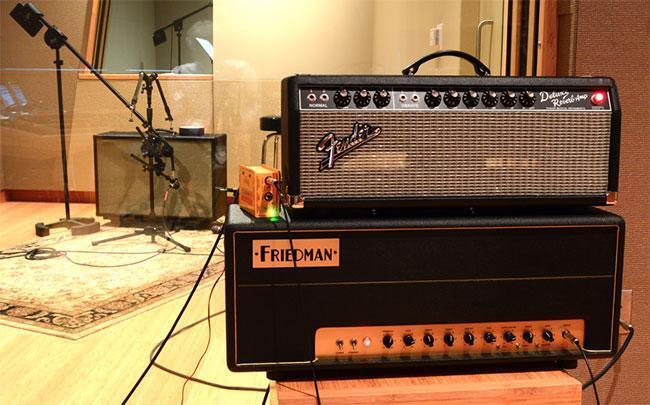
The Fender ’65 Deluxe Reverb and Friedman BE-100 amp heads in Sweetwater Studio B control room feeding the PRS J-Mod 2×12″ cabinet.
For these recordings, we decided to use two guitar sounds — a dirty sound and a clean sound. Don Carr joined me in the studio with two guitars: a Gibson Les Paul Custom he used for the dirty sound and an LsL Carl Verheyen Special for the clean sound. Don wrote two parts that explored a range of sounds for each tone, and we dialed in the sound by plugging the guitar straight into the amp. Then we recorded a reference track. For the dirty sound, we used a Friedman BE-100, and the clean sound utilized Sweetwater Studios’ highly customized Fender ’65 Deluxe Reverb. Each head was routed into a PRS J-Mod 2 x 12″ cabinet sitting on an Auralex GRAMMA v2 Isolation Riser. Once we were satisfied with the each sound, we plugged the guitar into the DI of a BAE 1073MP Dual and routed that to a Radial Re-amp Kit, which fed the amp chain. We compared the sound of the re-amped signal to the original “guitar straight into amp” signal and satisfied ourselves that we weren’t losing anything sonically. Then we recorded the keeper performances for the dirty and clean clips straight into Pro Tools at 24-bit/96kHz via a Focusrite RedNet 5 clocked to an Antelope Isochrone Trinity.

“The challenge was to come up with two short musical examples that highlighted the differences in the mics. The goal was to use as many nuances as I could: muted notes, ringing notes, held chords, high register, low register, etc., in a short clip, while creating something we could endure listening to a thousand times! Seriously, this is one case where the performance needed to be transparent so that the focus could be on the sound. One dirty tone and one clean tone seemed like an obvious choice, and the guitar/amp selection process was pretty straightforward as well. I like the PRS J-Mod cabinet because the universal familiarity of Celestion speakers is great for this type of comparison test. The J-Mod’s G12-65 Heritage speakers have a nice warmth that lends itself to both clean and dirty sounds and retains that quality at fairly high SPLs.
Once I had crafted musical examples that I felt were appropriate, we recorded the performances directly into Pro Tools, and then the process was as easy as switching mics and pressing the Record button. In fact, my job during the entire recording process was to swap the cables from the re-amp box and speaker cabinet into the appropriate amp. A fun afternoon’s work, for sure!” – Don Carr
The amplifier settings are shown in the photos below.
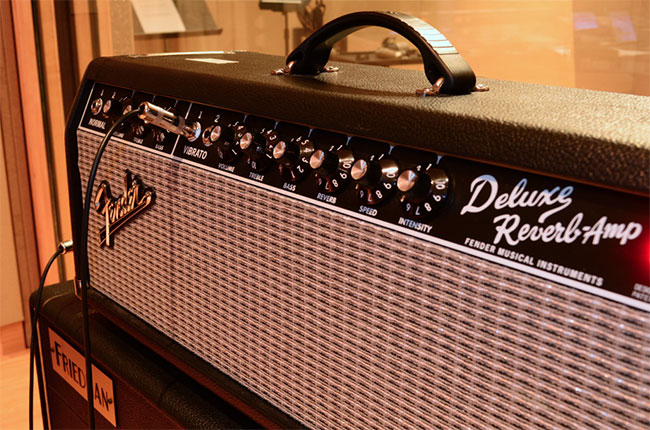
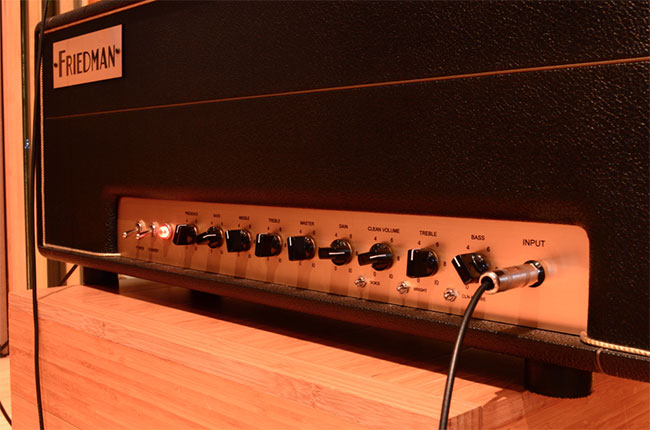
Miking the guitar cabinets
Don and I spent hours experimenting with mic positions on cabinets (read about it in my article The Importance of Mic Placement for Guitar Amps) and used that research to guide our mic placement on the PRS J-Mod cabinet. Starting with the SM57 patched into a Chandler Limited TG Channel Mark II mic preamp, we determined the mic position that best translated the tone. Then we marked that position with 1) a horizontal indicator (which was not a laser during the testing) to align the center of the mic plus 2) a laser that indicated the vertical position and the distance from the speaker grille, which was 1-¾”. Using those two indicators, we were able to place all the mic diaphragms in the identical location.
NOTE: Some microphones, like the Neumann U 87 Ai, utilize large elastic shockmounts or, as with the Shure SM7B, windscreens, which restricted us from positioning them identically, but the difference in distance from the grille was never more than a fraction of an inch. It’s not always obvious where the diaphragm is inside a mic, but with a flashlight and some ingenuity, we figured it out.
FOR THE ENGINEERS: You can see a few of the tracks from the original Pro Tools session in the image below, zoomed in to the waveform level, which shows how closely all the mics were aligned. None of the tracks were nudged or time-aligned at all after the original recording. You can see the waveforms for each track (in the highlighted section) and see that the leading edges from the different mics are very closely aligned in time.
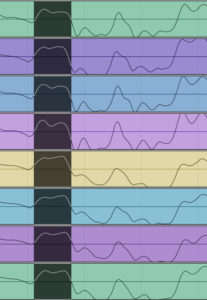
Next, we set the level and recorded both clean and dirty clips. At the mic position, the amp was cranking out 113dB SPL (Sound Pressure Level) on the dirty sound and 112dB SPL on the clean sound. No EQ or any other processing was applied. The signal path was the guitar signal from Pro Tools Out > Re-amp > Guitar Amp > Cabinet > Mic > Preamp > Pro Tools In.
Once the sound clips from the first mic were recorded, the re-amping made it a simple matter of swapping in a different mic in the same calibrated position, adjusting the preamp gain, and hitting record. Then we’d change the amp head (input and output) and record again. The levels were set on the preamp (ranging from 10dB to 30dB) for similar deflection on the Pro Tools meters and we recorded all 21 mics identically (dynamics, condensers, and ribbons). I originally planned to set levels utilizing a 1kHz tone, or possibly white or pink noise, but quickly learned how pointless that was. One of the greatest challenges for this comparison was adjusting the gain of these clips for fair evaluation (more details to follow).

What to listen for
As you listen to these clips, pay attention to the tone of the guitar. Listen for the top-end balance with the bottom end. Listen for the character and personality of the mic — does the mic lend anything distinctive to the sound? Listen for the definition between the notes. Listen for a mic that sounds like the tone you’d like to achieve. Consider which tones would sit well in a track and not require much EQ.
NOTE: I strongly recommend listening on quality speakers or headphones without knowing the identities of the mics. That way, you’ll get a more honest take on the sounds, because knowing which mic is which will probably influence your opinion.
Listen to all the dirty sound clips first with a pen and paper in hand, and write down which mics you prefer. Then make a different list of the ones you prefer on the clean sound. You may be surprised how your opinion changes depending on the guitar tone. Do any of these mics sound equally great on both sounds? For guitar players who mostly play live, those mics may be the best choice, since changing mics in the middle of a set isn’t usually an option. Lastly, once you have made your picks, take a look at how affordable the mics are. If you’re like us, you may discover several that are easily within reach that sound better than what you’re using now.
Listen to the guitar cabinet mics
Here are the sound clips as 320K MP3s grouped by Dirty and then Clean. Although the differences are clear by listening to these MP3 clips, I strongly encourage you to click on the link below, download the high-resolution (24-bit/96kHz) sound files, and open them in your DAW to listen at maximum fidelity. Having them in a DAW makes it easy to solo and switch between tracks. Plus, you can mix and match to find out how two mics sound when combined, such as an SM57 and an R-121.
Click here to download the 24/96 sound files in a Pro Tools session (280MB)
Click here to download the 24/96 sound files for users without Pro Tools (280MB)
Guitar Cabinet Mics – DIRTY
Shure SM57
Telefunken M80-SH
Telefunken M81-SH
Audix i5
sE Electronics V7
Sennheiser e609
Sennheiser e906
Beyerdynamic M 88 TG
Audio-Technica AE2300
Sennheiser MD 421 II
Shure SM7B
AKG C414 XLII
Neumann U 87 Ai
Neumann U 47 FET
Audio-Technica AT4047/SV
Audio-Technica AT5045
AEA N22
Royer R-121
Royer R-10
sE Electronics Voodoo VR1
Beyerdynamic M 160
Guitar Cabinet Mics – CLEAN
Shure SM57
Telefunken M80-SH
Telefunken M81-SH
Audix i5
sE Electronics V7
Sennheiser e609
Sennheiser e906
Beyerdynamic M 88 TG
Audio-Technica AE2300
Sennheiser MD 421 II
Shure SM7B
AKG C414 XLII
Neumann U 87 Ai
Neumann U 47 FET
Audio-Technica AT4047/SV
Audio-Technica AT5045
AEA N22
Royer R-121
Royer R-10
sE Electronics Voodoo VR1
Beyerdynamic M 160
For Engineers — Observations About Matching Levels
If you are interested in the technical details, read on to learn more about the level-matching techniques we used for matching these audio clips.
Level matching is critical because otherwise people will generally prefer whichever sound is louder, even if it’s only louder by a few dB, sometimes even just a fraction of a dB. How do you calibrate levels when it comes to guitar cabinet recordings? Very carefully, as I discovered. The drastic differences in frequency response among these mics, combined with varying proximity effect, meant that typical methods of calibration were completely derailed. The clean sound clips were relatively easy to match, but matching the dirty sound clips was incredibly challenging.
For my first attempt, I matched the peak levels of all the tracks. Using all the same performance with the mics in exactly the same place — it should work, right? Wrong. The apparent levels were all over the map, with some mics sounding 6dB–9dB softer than others.
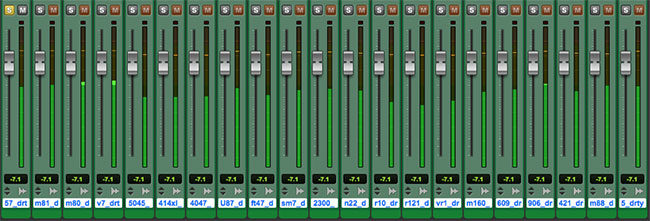
With peak levels matched precisely at -7.1dBFS, the level differences are readily apparent on the meters.
Here’s why. The amount of energy in one mic might be focused in the low-frequency spectrum, such as an R-121, while another mic, for example the SM57, focused the energy in the upper midrange. So I decided to try metering using a Loudness Meter — the Waves WLM utilizing the LUFS (Loudness Units per Full Scale) scale — a scale designed for normalizing volume of dialog and program content for broadcast, so I thought it would be perfect for this task.

The Waves WLM Loudness Meter shows the Momentary peak hold value numerically to the right of the meter (-23.6). The LPF and HPF are set to 3000 and 300Hz respectively.
First I tried a full bandwidth measure using the Momentary LUFS scale. After matching all the clips to within 0.5dB (nudging the gain of the clips by as much as 4dB–5dB), I was surprised to find the levels were better, but still wildly different. So I band-limited the audio using the Custom Pre Filtering function, with a highpass of 300Hz and a lowpass of 3kHz. This enabled me to eliminate the extreme low-frequency content of some of the condenser and ribbon mics and hopefully craft a more equal comparison in the ear’s most sensitive frequency range. The result? We were closer, but it was still unacceptable, as the volume levels seemed different when switching from some mics to others.
I finally decided to use an old-fashioned SPL meter with a VU scale, set to A-weighting and Slow response. This allowed me to approximate what the ear would perceive in terms of volume, and I selected a loud section (of short duration) and made the meter deflection the same for each of the 21 dirty clips. When switching among clips, this finally offered an equal volume approximation. You may notice that the levels, in terms of digital metering, are not the same, but what you hear will be very similar in apparent volume.
While the differences in the sounds you’ll hear here are largely related to two things — frequency response and proximity effect — being able to see the differences on an identical program was a fascinating benefit. Here’s an example:
When comparing the SM57 recording with the Royer R-121, matched for peak levels (-7.1dBFS), the output level from those two mics was the same at only one frequency: 92Hz. That means that below 92Hz, the Royer had more output, and above 92Hz, the SM57 had more output. When the same two mics were matched for apparent level, then the crossover frequency (where the output levels matched) was about 500Hz. The output plotted by frequency can be seen in the image below using the Waves PAZ – Frequency plug-in, displaying Peak Hold with RMS detection.

Using the Waves PAZ frequency analyzer plug-in on the dirty sound, you can see the tilt of the frequency content of the SM57, indicated by the red line, versus the frequency content of the R-121, indicated by the blue line. Notice that the lines only cross at 499Hz.
Choosing the best guitar mic for your amp
I’ve been blessed to be able to compare dozens of mics on lots of different guitar cabinets and amps using a wide variety of guitars in the hands of more players than I can count. It is endlessly fascinating to me how much impact every single component in the chain makes. The mic clearly has a huge influence on that. I hope you learned a lot listening to these clips and found a few new mics you need to try. I know I did.
And no matter which of these mics you like best, Sweetwater can provide the mic you need to make your guitar rig sound its absolute best. Shop all microphones at Sweetwater or give your Sales Engineer a call at (800) 222-4700.





